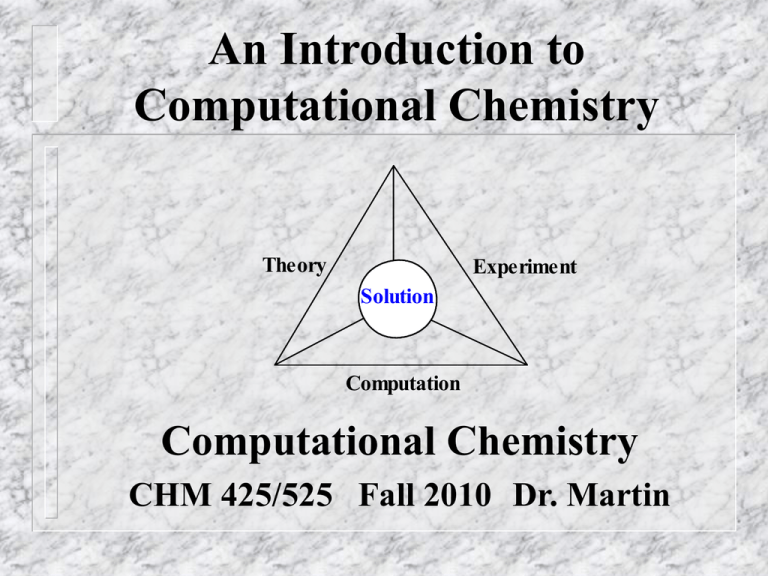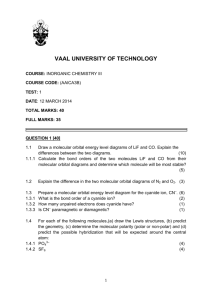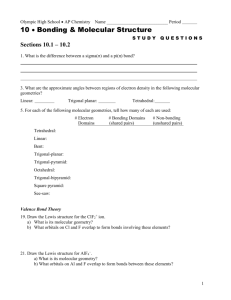Introduction to Computational Chemistry
advertisement

An Introduction to Computational Chemistry Theory Experiment Solution Computation Computational Chemistry CHM 425/525 Fall 2010 Dr. Martin What is Computational Chemistry? Use of computers to aid chemical inquiry, including, but not limited to: – – – – – – – Molecular Mechanics (Classical Newtonian Physics) Semi-Empirical Molecular Orbital Theory Ab Initio Molecular Orbital Theory Density Functional Theory Molecular Dynamics Quantitative Structure-Activity Relationships Graphical Representation of Structures/Properties Levels of Calculation Molecular mechanics...quick, simple; accuracy depends on parameterization. Semi-empirical molecular orbital methods...computationally more demanding, but possible for moderate sized molecules, and generally more accurate. Ab initio molecular orbital methods...much more demanding computationally, generally more accurate. Levels of Calculation... Density functional theory…more efficient and often more accurate than ab initio calc. Molecular dynamics…solves Newton’s laws of motion for atoms on a potential energy surface; temperature dependent; can locate minimum energy conformations. QSAR…used to predict properties of new structures or predict structures that should have certain properties (e.g., drugs) Relative Computational “Cost” Molecular mechanics...cpu time scales as square of the number of atoms... Calculations can be performed on a compound of ~MW 300 in a minute on a pc, or in a few seconds on a parallel computer. This means that larger molecules (even large peptides) and be modeled by MM methods. Relative Computation “Cost” Semi-empirical and ab initio molecular orbital methods...cpu time scales as the third or fourth power of the number of atomic orbitals (basis functions) in the basis set. Semi-empirical calculations on ~MW 300 compound take a few minutes on a pc, seconds on a parallel computer (cluster). Molecular Mechanics Employs classical (Newtonian) physics Assumes Hooke’s Law forces between atoms (like a spring between two masses) Estretch = ks (l - lo)2 Bond Stretching Energy 350 300 Energy, kcal/mol 250 200 150 100 50 0 0 graph: C-C; C=O 1 2 Internuclear Distance 3 Molecular Mechanics... Similar calculations for other deviations from “normal” geometry (bond angles, dihedral angles) Based on simple, empirically derived relationships between energy and bond angles, dihedral angles, and distances Ignores electrons and effect of p systems! Very simple, yet gives quite reasonable, though limited results, all things considered. Properties calculated by MM: “Steric” or Total energy = sum of various artificial energy components, depending on the program...not a “real” measurable energy. Enthalpy of Formation (sometimes) Dipole Moment Geometry (bond lengths, bond angles, dihedral angles) of lowest energy conformation. Molecular Mechanics Forcefields MM2, MM3 (Allinger) MMX (Gilbert, in PCModel) MM+ (HyperChem’s version of MM2) MMFF (Merck Pharm.) Amber (Kollman) OPLS (Jorgensen) BIO+ (Karplus, part of CHARMm) (others) Semi-Empirical Molecular Orbital Theory Uses simplifications of the Schrödinger equation to estimate the energy of a system (molecule) as a function of the geometry and electronic distribution. The simplifications require empirically derived (not theoretical) parameters (or fudge factors) to allow calculated values to agree with observed values. Properties calculated by molecular orbital methods: Energy (enthalpy of formation) Dipole moment Orbital energy levels (HOMO, LUMO, others) Electron distribution (electron density) Electrostatic potential Vibrational frequencies (IR spectra) Properties calculated by molecular orbital methods... HOMO energy (Ionization energy) LUMO energy (electron affinity) UV-Vis spectra (HOMO-LUMO gap) Acidity & Basicity (proton affinity) NMR chemical shifts and coupling constants others Semi-Empirical MO Theory Types Hückel (treats p electrons only) CNDO, INDO, ZINDO MINDO/3 MNDO AM1, PM3 (currently most widely used) Collections of these are found in AMPAC, MOPAC, HyperChem, Spartan, Titan, etc. Ab Initio Molecular Orbital Theory Uses essentially the same (Schrödinger) equation as semi-empirical MO calculation Introduces fewer approximations, therefore needs fewer parameters (“fudge factors”) Is more “pure” in relation to theory; if theory is correct, should give more accurate result. Takes more cpu time because there are fewer approximations. Variations of Ab Initio Theory HF (Hartree-Fock) – Moller-Plesset perturbation theory – includes some electron correlation; MP2, MP3 Configuration Interaction – electron experiences a ‘sea’ of other electrons QCISD, QCSID(T) All of the above involve choices of basis sets: – STO-3G, 3-21G, 6-31+G, 6-311G**, etc. (many) Basis Sets STO-3G (Slater-type orbitals approximated by 3 Gaussian functions) Split Basis Sets... Use two sizes of Gaussian functions to approximate orbitals: 3-21, 6-31, 6-311 (large and small orbitals) additional features which can be added to any basis set: – – – polarization functions (mixes d,p with p,s orbitals) e.g., 6-31G** [= 6-31G(d,p)] diffuse functions + (allows for distant interactions) Molecular Geometry Molecular geometry can be described by three measurements: – – – bond length (l) bond angle (a) dihedral angle (q) l H H H C H C H a H H q H H H H H Bond length Distance between nuclei of adjacent atoms that are covalently bonded (can also describe distance between non-covalently bonded, or non-bonded atoms) But atoms are in constant motion, even at absolute zero! How do we define the “distance” between them? Measurements of bond length X-ray crystallography – – Gas Phase electron diffraction – – distances in crystalline solid; only ‘heavy’ atoms geometry may differ from solution phase weighted average distances in gas phase not a single conformation; solvent effects ignored Neutron diffraction – only heavy atoms included Equilibrium bond length Molecules exist in an ensemble of energy states which depends on T. Several vibrational and rotational states are Energy populated for each electronic state. Geometry optimization computations determine the equilibrium bond length. r0, r1, r2... v3 v2 v1 v0 zero point energy eq. bond length Distance between atoms Units of Measurement Bond lengths are usually reported in Angstroms (1Å = 10-10 m = 100 pm); this is not an SI unit, but it is convenient because most bond lengths are of 1 to 2 Å. Angles are measured in degrees. Potential energy is usually measured in kcal/mol (1 kcal/mol = 4.184 kJ/mol). Some Applications... Calculation of reaction pathways & energies Determination of reaction intermediates and transition structures Visualization of orbital interactions (forming and breaking bonds as a reaction proceeds) Shapes of molecules, including large biomolecules Prediction of molecular properties …more Applications QSAR (Quantitative Structure-Activity Relationships) Remote interactions (those beyond normal covalent bonding distance) Docking (interaction of molecules, such as pharmaceuticals with biomolecules) NMR chemical shift prediction Modeling Charge-Transfer Complexation of Amines with Singlet Oxygen N-O “bond” distance = 1.55 Å DqN = +0.35esu DqOdistal = -0.33 esu Modeling Aggregation Effects on NMR Spectra N-Phenylpyrrole has a concentrationdependent NMR spectrum, in which the protons are shifted upfield (shielded) at higher concentrations. We hypothesized that aggregation was responsible. Modeling Aggregation Effects on NMR Spectra... Two monomers were modeled in different positions m a p o parallel to one another, and the energy was plotted vs. X and Y. The NMR of the minimum complex was calculated. 7.8 7.6 7.4 m o mean dimer (calc'd.) 7.2 6.8 7.0 pa mean monomer (calc'd.) 8.2 8.0 7.8 7.6 7.4 7.2 7.0 6.8 Orbital Perturbations Proximity of orbitals results in perturbation. This shows methane with one H 2.0Å above the middle of the p bond of ethene This leads to alterations in the magnetic field, which affects the NMR chemical shift Magnetic Shielding Surfaces





